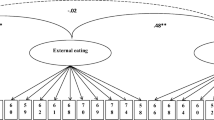Abstract
One of the most frequently used measures of eating and weight problems is the Eating Attitudes Test (EAT). The paper discusses conceptual heterogeneity in the EAT in the light of eating disorder continuum theory. Psychometric qualities of the Norwegian 12-item version of the EAT was based on a sample of 224 female and 261 male adolescents aged 14–15 years. Generalizability theory enabled us to study the impact of multiple sources of measurement errors of the EAT-12. The analyses suggest that acceptable generalizability is achieved by the present design on applying 4 items within 3 categories of the EAT. Alternative designs are suggested, and the utility of G-theory is discussed. The results also provide evidence of a gender difference in the structure of the universe score variance. Non-clinical adolescents’ ways of organizing information about food and eating are discussed in the light of gender differences.
Similar content being viewed by others
References
Garner D.M., Garfinkel P.E.: The Eating Attitudes Test: An index of the symptoms of anorexia nervosa. Psychol. Med., 9, 273–279, 1979.
Szmukler G.I.: The epidemiology of anorexia nervosa and bulimia. J. Psychiatry Res., 19, 143–153, 1985.
King M.B.: Eating disorders in a general practice population: Prevalence, characteristics and follow-up at 12–18 months. Psychol. Med., suppl. 14, 1989.
Garner D.M., Olmsted M.P., Bohr Y., Garfinkel P.E.: The Eating Attitudes Test: Psychometric features and clinical correlates. Psychol. Med. 12, 871–878, 1982.
Scheinberg Z., Koslowsky M., Bleich A., Mark M., Apter A., Danon Y., Solomon Z., Babur I.: Sensitivity, specificity, and positive predictive value as measures of prediction accuracy: The case of the EAT-26. Educational and Psychological Measurement, 53, 831–839, 1993.
Furnham A., Boughton L.: Eating behaviour and body dissatisfaction among dieters, aerobic exercisers and a control group. Eur. Eating Disord. Rev. 3, 35–45, 1995.
Lee S., Lee A.M., Leung T.: Cross-cultural validity of the Eating Disorder Inventory: A study of Chinese patients with eating disorders in Hong Kong. Int. J. Eating Disord., 23, 177–188, 1998.
Button E.J., Whitehouse A.: Subclinical anorexia nervosa. Psychol. Med., 11, 509–516, 1981.
Williams R.L.: Use of the Eating Attitudes Test and Eating Disorder Inventory in adolescents. J. Adolesc. Health, 8, 266–272, 1987.
Wichstrøm L.: Social, psychological and physical correlates of eating problems. A study of the general population in Norway. Psychol. Med., 25, 567–579, 1995.
Nylander J.: The feeling of being fat and dieting in a school population: Epidemiologic interview investigation. Acta Sociomedica Scand., 3, 17–26, 1971.
Williamson D.A., Anderson D.A., Jackman L.P., Jackson S.R.: Assessment of eating disordered thoughts, feelings, and behaviors. In: Allison D.B. (Ed.) Handbook of assessment methods for eating behaviors and weight-related problems. Measures, theory, and research. California, Sage Publications Inc., 1995, pp. 561–580.
Lavik N.J., Clausen S.E., Pedersen W.: Eating behaviour, drug use, psychopathology and parental bonding in adolescents in Norway. Acta Psychiatr. Scand., 84, 387–390, 1991.
Smead V.S., Richert A.J.: Eating Attitude Test factors in an unselected undergraduate population. Int. J. Eating Disord., 9, 211–215, 1990.
Cronbach L.J., Gleser G.C., Nanda H., Rajaratnam N.: The dependability of behavioral measurements: Theory of generalizability for scores and profiles. New York, Wiley, 1972.
Schoemaker C., van Strien T., van der Staak C.: Validation of the Eating Disorders Inventory in a nonclinical population using transformed and untransformed responses. Int. J. Eating Disord., 15, 387–393, 1994.
Cronbach L.J.: Methodological studies: A personal retrospective. In: Snow R.E., Wiley D.E. (Eds.) Improving inquiry in social sciences: A volume in honor of Lee J. Cronbach. Hills dale, Lawrence Erlbaum, 1991, pp. 385–410.
Messick S.: Validity of psychological assessment. Am. Psychol., 50, 741–749, 1995.
Shavelson R.J., Webb N.M.: Generalizability theory. A primer. California, Sage Publications Inc., 1991.
Rabinowitz W., Eikeland H-M.: Estimating the reliability of test with clustered items. Scand. J. Ed. Res. (Pedagogisk forskning), 8, 85–106, 1964.
Rajaratnam N., Cronbach L.J., Gleser G.C.: Generalizability of stratified-parallel tests. Psychometrika, 30, 39–56, 1965.
Brennan R.L.: Elements of generalizability theory (rev. ed.). Iowa City, IA, American College Testing, 1992.
Crick J.E., Brennan R.L.: Manual for GENOVA: A Generalized Analysis of Variance System. Iowa, ACT Technical Bulletin, 1983.
Wang M.C., Stanley J.C.: Differential weighting: A review of methods and empirical studies. Rev. Educ. Res., 40, 663–705, 1970.
Benson J., Hagtvet K.A.: The interplay among design, data analysis and theory in the measurement of coping. In Zeidner M., Endler N.S. (Eds.) Handbook of coping: Theory, research, application. New York, Wiley, 1996, pp. 83–106.
Author information
Authors and Affiliations
Rights and permissions
About this article
Cite this article
Engelsen, B.K., Hagtvet, K.A. A generalizability study of the Eating Attitudes Test (EAT-12) in non-clinical adolescents. Eat Weight Disord 4, 179–186 (1999). https://doi.org/10.1007/BF03339734
Received:
Accepted:
Published:
Issue Date:
DOI: https://doi.org/10.1007/BF03339734




